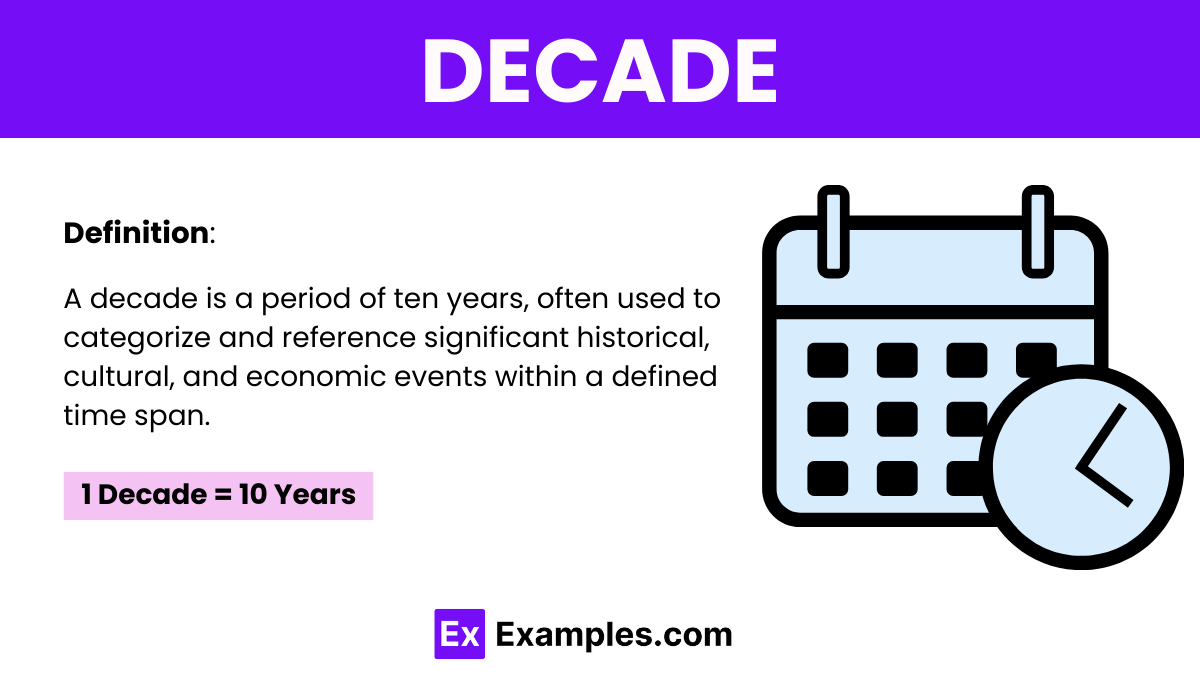If a person was born in 1985, which decade did they spend their teenage years in?
1970s
1980s
1990s
2000s


A decade is a period of ten years. This term originates from the Latin word “decas,” derived from “deca,” which means ten. Decades are commonly used to categorize and reference specific periods in history, notably in culture, politics, and economics. For instance, the 1980s are renowned for distinctive fashion trends and significant technological advancements. Consequently, understanding decades helps us appreciate changes over time and forecast future trends. By dividing time into decades, historians and scholars effectively analyze patterns and transformations in society.
Primarily, we recognize decades for their role in framing historical eras, cultural shifts, and economic changes. For example, the 1990s are celebrated for rapid advancements in technology and global connectivity. Moreover, by organizing historical events into decades, it becomes simpler to observe evolution and continuity in societal trends. This methodical approach enables scholars to trace developments and forecast potential future patterns, making the study of decades crucial for understanding past and predicting future dynamics.

Several tools and methodologies are employed to measure a decade effectively. Here are some primary instruments:
A decade consists of ten sequential years. Typically, these years start with a year ending in zero and conclude with a year ending in nine. For instance, the decade from 2000 to 2009 begins with the year 2000 and ends with 2009.
To illustrate, when discussing the 1990s, we refer to the span from 1990 to 1999. Each decade commences with a year that marks the end of the previous decade and ushers in a new set of ten years. This period is pivotal as it encapsulates significant milestones and transformations within various domains such as technology, politics, and culture.
Furthermore, examining each year within a decade allows scholars to track gradual changes and abrupt shifts that characterize the decade. This structured observation helps illuminate broader historical trends and societal movements, providing a clearer picture of how events unfold over time and shape the future.
A decade plays a crucial role in understanding historical and societal changes. Spanning ten years, a decade offers a substantial period to observe developments and transformations in society, culture, and technology. Additionally, it serves as a lens through which to view the effects of policies and major events over a longer stretch of time.
Moreover, decades help historians and analysts categorize and simplify the study of time periods. For example, the 1960s are often associated with cultural revolutions and political movements, providing clear markers of change. This periodization allows for a structured analysis of trends and patterns that might not be as apparent when looking at individual years.
Furthermore, by dividing history into decades, educators and scholars can present a more organized narrative to students and the public, making it easier to digest complex information. This division also aids in predicting future trends by examining past cycles, enhancing strategic planning in fields like economics, urban planning, and public policy.

Here’s a table format for the concept of a decade, showing its relation to other common units of time:
| Time Unit | Conversion from Decades |
|---|---|
| Years | 1 decade = 10 years |
| Months | 1 decade = 120 months |
| Weeks | 1 decade = approximately 521 weeks |
| Days | 1 decade = approximately 3652 days |
| Hours | 1 decade = approximately 87,648 hours |
| Minutes | 1 decade = approximately 5,258,880 minutes |
| Seconds | 1 decade = approximately 315,532,800 seconds |
Understanding how to convert decades to other units of time is essential for historical analysis, project planning, and understanding various timelines. Here’s a straightforward guide to converting decades to and from other common units of time:

Fill in the Blanks:
Answers:
No, 7 years is not half a decade. A decade consists of 10 years, so half a decade would specifically be 5 years, making 7 years more than half.
Three decades amount to 30 years. Each decade consists of 10 years, so multiplying by three, we effortlessly arrive at the total, confirming that 3 decades equal 30 years.
A decade is calculated by counting 10 consecutive years. Starting from any given year, the count extends to the end of the tenth year, completing the decade.
Text prompt
Add Tone
10 Examples of Public speaking
20 Examples of Gas lighting
If a person was born in 1985, which decade did they spend their teenage years in?
1970s
1980s
1990s
2000s
The 2000s are also known as which decade?
The Noughties
The Seventies
The Sixties
The Fifties
Which decade is referred to as the Roaring Twenties?
1910s
1920s
1930s
1940s
If a historical event occurred in 1955, which decade does it belong to?
1940s
1950s
1960s
1970s
In which decade did the Great Depression primarily occur?
1920s
1930s
1940s
1950s
The decade known for the rise of grunge music is which of the following?
1970s
1980s
1990s
2000s
Which decade witnessed the first moon landing?
1960s
1970s
1980s
1990s
The decade of the 1980s is also known for the influence of which president in the United States?
John F. Kennedy
Lyndon B. Johnson
Richard Nixon
Ronald Reagan
What is a decade?
5 years
10 years
15 years
20 years
Which of the following decades is the 1990s?
1980-1989
1990-1999
2000-2009
2010-2019
Before you leave, take our quick quiz to enhance your learning!

